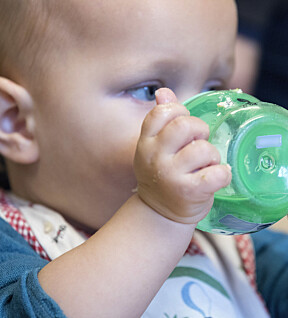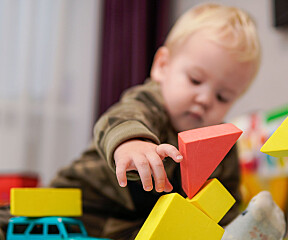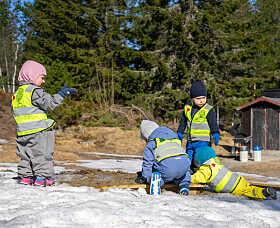
More stress hormones found in children cared for at home than in kindergartens
Does the research finding flip our understanding of stress in the nursery and kindergarten setting?
Previous research has revealed that toddlers display high stress levels in kindergartens.
Research from Norway and other European countries shows that the level of the stress hormone cortisol rises in children during the day.
But what does research show about children who are cared for at home? The truth is that stress studies have not included this population in their research.
Saliva reveals stress level
Finnish researchers therefore examined the saliva of more than 200 children divided into two groups. One group attended out-of-home childcare, while the other group of toddlers were at home during the day.
The study is part of Katja Tervahartiala's PhD degree at the University of Turku in Finland.
The saliva of the children, who were two years old on average, can reveal how much cortisol they have in their bodies.
We all secrete cortisol when we are stressed, and then the level drops again when we have calmed down.
Tervahartiala and her colleagues measured this hormone in the children's saliva. The measurements were carried out upon waking, mid-morning, mid-afternoon, and in the evening over two days.

Higher cortisol level among children at home
The researchers strongly expected that the children in kindergartens would have more stress hormones in their saliva.
But the results showed the opposite.
The children at home had higher levels of cortisol throughout the day than the kindergarten children.
Could this really be the case?
Tervahartiala does not want to conclude that being at home is more stressful based just on her own research. “But that is one of several possible explanations for the higher cortisol,” she says.
More predictable routines
The children in nurseries and kindergartens had a more consistent routine.
“We noticed that children’s sleeping time, waking time and eating time varied more in the home group,” says Tervahartiala.
This was also apparent in the questionnaires filled in by the parents and nursery staff.
“Routines are very helpful for children and can influence stress regulation,” says the Finnish researcher.
Higher education level among kindergarten mothers
The stress measurements in the Finnish children could also have other possible explanations. One of them is that the families in the two groups are slightly different.
The questionnaires showed that the kindergarten mothers had slightly more education than the mothers at home.
Even though the researchers took this into account in their analysis, they might not have captured the entire difference.
“Perhaps the at-home group includes families who struggle to provide good enough care,” says May Britt Drugli.
Drugli has done research on stress in Norwegian kindergartens and is a professor at NTNU and central Norway’s Regional Knowledge Centre for Child and Youth Mental Health and Child Welfare.

More depression among stay-at-home mothers
One of the Finnish PhD candidate’s more recent studies also substantiates this finding.
The researchers found a small group of children who had high and fluctuating levels of cortisol.
These toddlers were usually looked after at home, but also had another characteristic.
The mothers of these children had more frequent depression symptoms.
Both of these studies are part of the FinnBrain Research project.
Higher cortisol levels in Norwegian kindergarten children
But even if the groups are slightly different, is it perhaps time to let go of the worry about stress in the kindergartens?
Well, maybe not completely, says Drugli. Because even though the Norwegian studies have not included children being cared for at home, the children still differ from the Finnish ones.
The youngest Norwegian kindergarten children showed an abnormal stress pattern.
The level of cortisol should decrease during the day. It is highest when we wake up, and then it drops towards evening.
But among the youngest children, cortisol levels were higher in the afternoon than in the morning.
Maybe Finnish kindergartens are better?
The Finnish nursery children did have a similar increase in cortisol in the afternoon, but the level was never higher than the morning measurement.
So why is it that Norwegian children apparently become more stressed in their out-of-home care?
“Maybe Finnish kindergartens are better than Norwegian ones,” says Drugli.
Previous research involving older out-of-home care children has suggested that this may be true.
In any case, Finland and Norway are slightly different. In a 2020 OECD overview, only 37 per cent of Finnish children under the age of two were enrolled in out-of-home nursery care. The corresponding figure for Norwegian children is 58 per cent.
Since most Norwegian children start kindergarten when they are one year old, fully 81 per cent of Norwegian one-year-olds were enrolled in kindergartens in 2022, according to figures from Statistics Norway.
Challenging to have control group in Norway
One of the reasons more people stay at home in Finland is probably that Finnish parents are able to receive financial support to look after their children until they are three years old.
This difference makes it difficult to carry out similar research on Norwegian children.
Drugli points out that almost all one-year-olds attend kindergartens in Norway.
A control group with at-home care children would thus be even less comparable to kindergarten children in Norway than to those in Finland.
We don't know what level of stress hormone is harmful
The research on cortisol also has another weakness. No one knows for sure how high the cortisol level has to be for it to affect children negatively.
“We don’t yet know whether these cortisol levels are harmful stress or simply stress that contributes to learning,” says Drugli.
“It’s almost certainly not so-called toxic stress, but we don’t know whether it could still lead to vulnerabilities in the long term.”
Children would need to be followed until they become adolescents and adults to find this out.
Children need some stress to learn
Tervahartiala also clarifies that stress in the kindergaten can be a good thing – as long as there isn't too much of it.
“In fact, children need some mild stress to learn new things and to learn to regulate their emotions. And when the stress is at a manageable level, we learn to tolerate stress better,” says the researcher.
However, Tervahartiala adds, in order for children to really learn to handle their stress reactions, they are completely dependent on having safe and good adults around them – whether it’s the nursery staff, parents or other carers.
References:
Katja Tervahartiala et.al: Toddlers' diurnal cortisol levels affected by out-of-home, center-based childcare and at-home, guardian-supervised childcare: comparison between different caregiving contexts. European Child & Adolescent Psychiatry, 2020.
Katja Tervahartiala et.al: Latent profile analysis of diurnal cortisol patterns at the ages of 2, 3.5, and 5 years: Associations with childcare setting, child individual characteristics, and maternal distress. Psychoneuroendocrinology, 2023.
———
Read the Norwegian version of this article at forskning.no






































